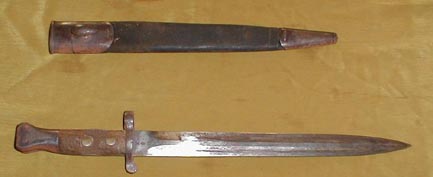British Pattern 1888 MkI, Type 2
"Lee-Metford" Bayonet

This is a double-edged bayonet originally manufactured to fit the Pattern 1888 Lee-Metford Infantry Rifle. These likely saw service in the Boer War and WWI.
They are very functional and of high-quality manufacture.
The hilt incorporates an odd-shaped pommel with push-button/internal-spring
latch, steel crossguard. The grips are of wood and are usually held in place by two brass rivets; an oil-hole is present behind the second rivet.
The blade is a double-edge type, unfullered, with a medial rib the runs from the ricasso to the blade tip; bright finish.
These are found in four basic variations:
- MkI, 1st Type - three brass rivets in grips;
- MkI, 2nd Type - two brass rivets and an oil/clearance hole at the rear of the second rivet;
- MkII - oil/clearance hole is no longer in the grip, but in the pommel; rear rivet is closer to the pommel; this was the first of the series intended solely for the Lee-Enfield Infantry Rifle.
- MkIII - metal hilt is "browned" and grips are held in place by two screw/nut sets.
Various British proofs and manufacturer's marks are usually on the ricasso, both sides. This one was made by Robert Mole & Sons of Birmingham, England in the mid-1890s. It also bears the
"X" blade proof-mark; the "broad arrow" over "WD" (War Department) Government acceptance mark; and a unique Birmingham inspectors number/mark with the "crown over B over 35."
The scabbards are of blued steel-mounted brown leather (I have seen black), with a single elongated oval "frog" stud.
This bayonet was the predecessor to the British Pattern 1903 series.


